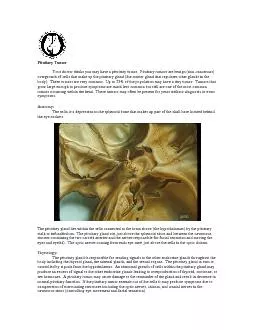PDF-Pituitary Tumor Your doctor thinks you may have a pituitary tumor.
Author : briana-ranney | Published Date : 2015-09-25
The pituitary gland lies within the sella connected to the brain above the hypothalamus by the pituitary stalk or infundibulum The pituitary gland sits just above
Presentation Embed Code
Download Presentation
Download Presentation The PPT/PDF document "Pituitary Tumor Your doctor thinks you..." is the property of its rightful owner. Permission is granted to download and print the materials on this website for personal, non-commercial use only, and to display it on your personal computer provided you do not modify the materials and that you retain all copyright notices contained in the materials. By downloading content from our website, you accept the terms of this agreement.
Pituitary Tumor Your doctor thinks you may have a pituitary tumor.: Transcript
Download Rules Of Document
"Pituitary Tumor Your doctor thinks you may have a pituitary tumor."The content belongs to its owner. You may download and print it for personal use, without modification, and keep all copyright notices. By downloading, you agree to these terms.
Related Documents














